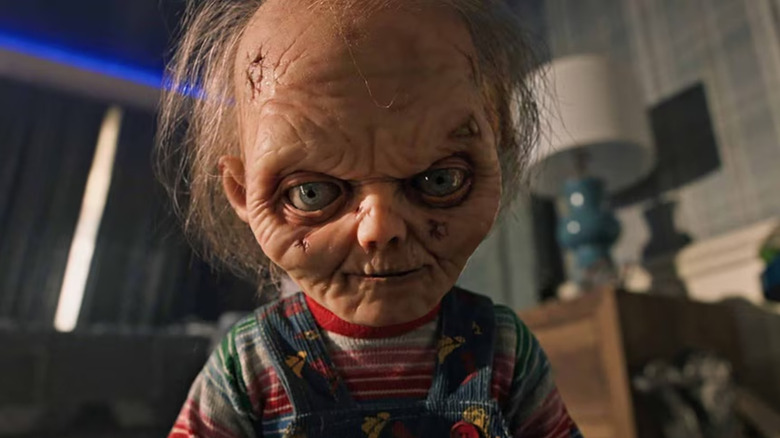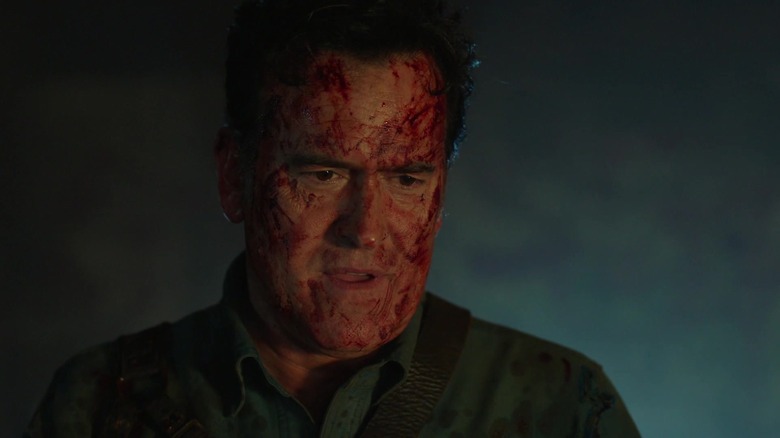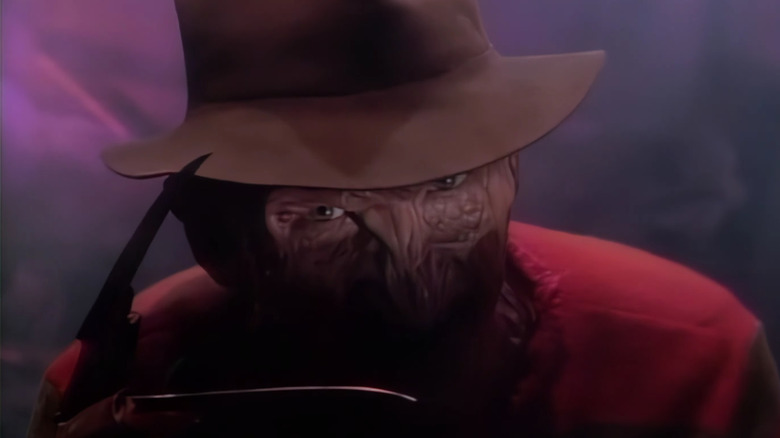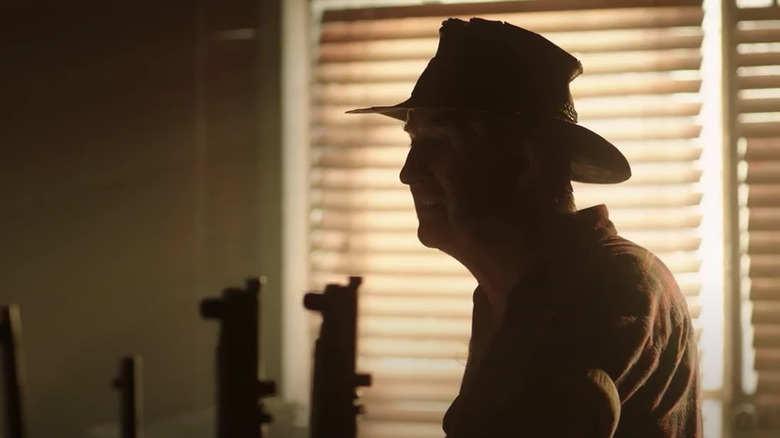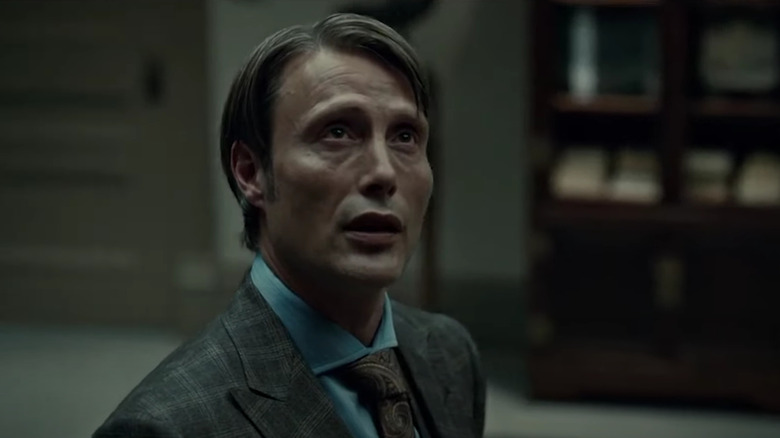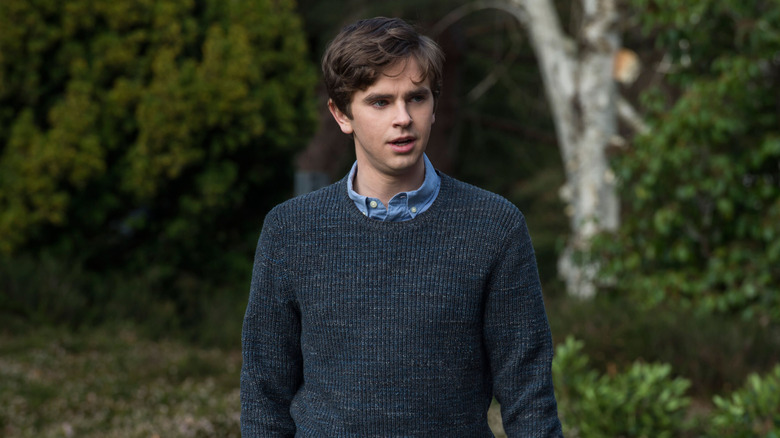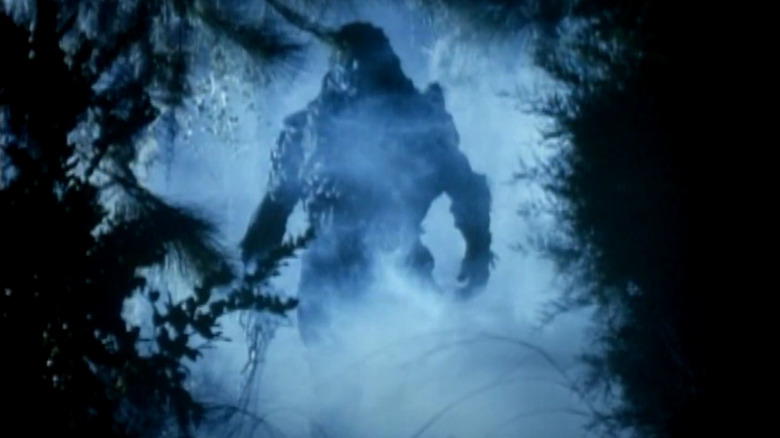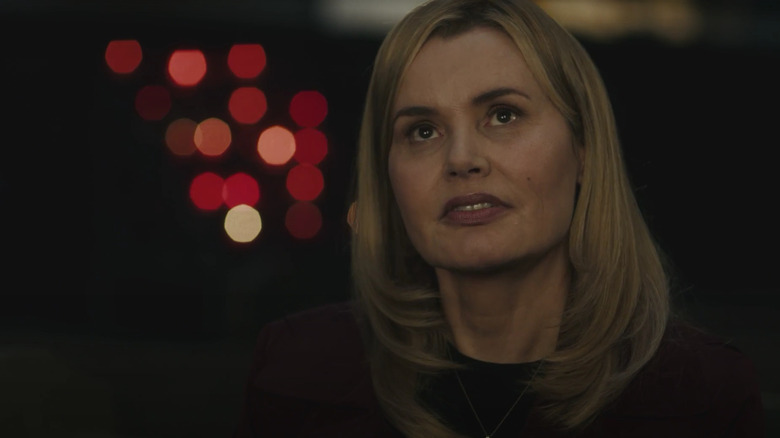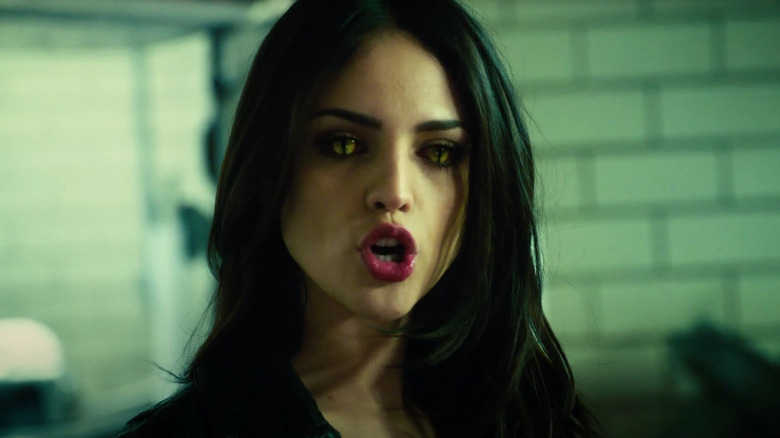10 Horror Movies That Turned Into Terrifying TV Shows
It used to be that if a horror movie was even a moderate success, the studio would milk it with cheaper and same-ier sequels until the gravy train ran dry and people got bored. Nowadays, like the most classic movie monsters, franchises never die. Even if the box-office returns stop justifying more movies, the brand identification can justify a TV series. In the age of streaming, everybody wants one. In some cases, the same actors and creative team will continue the exact same story where it left off. In others, the slate gets wiped clean for a full reboot. Both approaches have yielded crowd-pleasing results, and we'll politely ignore shows like "Friday the 13th: The Series" that have nothing whatsoever to do with the name they're cashing in on.
Horror may have yet to find its "M*A*S*H," a TV spin-off of a movie that became so successful in its own right that people actually think of the show first. That doesn't mean it hasn't come close, though. From direct sequels to authorized spin-offs and reboots, here are 10 terrifyingly good TV shows based on horror movies. For simplicity's sake, we've stuck to films that were horror first and foremost: "Westworld" and "The Terminator," for instance, spawned awesome TV reboots, but they were primarily sci-fi.
The following may include genre hybrids, but in each case, horror is what viewers think of first.
The Evil Dead/Ash vs. Evil Dead
After years of endless fan questions about whether and when a fourth "Evil Dead" movie with director Sam Raimi and star Bruce Campbell might happen, the duo finally did one better — a three-season TV show, full of gore, humor, and surprising depth for a series based around slapstick violence and demon possession.
Reconnecting with an older Ashley J. Williams (Campbell) who's still trying to live a party-boy lifestyle, the series brings back even more demonic threats to the world, including returning and new monsters, and a deepening of the mythology surrounding the Kandarian dagger (which always felt more improvised than anything). Ash got two younger, skeptical sidekicks in Kelly (Dana DeLorenzo) and Pablo (Ray Santiago), as well as a brilliant bit of stunt-casting for his dad, who was played by Lee Majors. The series didn't just bring back the jump scares and comedy that fans expected; it also reckoned with the fact that by today's standards, Ash is something of a poster-boy for toxic masculinity, and what might have been funny to him in the midst of a wacky adventure doesn't always play well in the real world.
Though it may have been canceled prematurely, the series finally ended roughly where the original movie trilogy was supposed to, with Ash sleeping for years and waking up in a post-apocalyptic future.
Child's Play/Chucky
A killer doll may seem like a limiting idea for a horror franchise, but "Chucky" creator Don Mancini used the TV show to take the story in truly weird and meta directions, casting several celebrities as themselves, Devon Sawa as multiple characters, and Brad Dourif's daughter, Fiona, in a fake beard as the younger version of Chucky. Virtually every major character from the franchise showed up in some form, with original "Child's Play" star Alex Vincent making a notable return to acting as a now-grown Andy.
Yet the show's new, young leads made the biggest impression, with Zackary Arthur and Björgvin Arnarson as young lovers Jake and Devon, and Alyvia Alyn Lind as their mean-girl bully-turned-ally. Unabashedly queer in sensibility, the story also brought back Chucky's nonbinary kid Glen/Glenda as twins, both played by Lachlan Watson. Meanwhile, Chucky himself ruined multiple lives and even went as far as to nuke the North Pole, while allowing Brad Dourif to have fun with multiple variant dolls, including one based on Marlon Brando in "Apocalypse Now."
Like "Ash vs. Evil Dead," "Chucky" ended prematurely, though in this case more painfully, with the heroes transformed into living dolls by a deranged toymaker played by John Waters. Mancini hasn't given up on the saga, though, and if history is any guide, he'll keep the story going somehow. Chucky, after all, remains a prime merchandise mover at Universal Studios' Halloween Horror Nights.
A Nightmare on Elm Street/Freddy's Nightmares
Though the pilot of "Freddy's Nightmares" was technically a "Nightmare on Elm Street" prequel, about the initial death-by-vigilantism of child-murderer Freddy Krueger, its long-term canonicity remains in question. The rest of the series, however, merely featured the now-scarred, wisecracking dream killer Freddy (Robert Englund) as a Rod Serling-like host, introducing supernatural tales from his hometown of Springwood. In an unusual structural quirk, each episode tended to tell two stories, with the second one centering on a character who had been secondary in the first part.
For older fans of the franchise who were more cynical, it has become commonplace to insult the show as cheesy and unworthy of Freddy. For younger teens, though, the surreal set design necessitated by the lower budget and dark themes, including nuclear war, made the show genuinely disturbing if you could suspend disbelief. Like many horror shows of the era, it also featured a mix of veteran actors like Dick Miller and George Lazenby, genre favorites like Jeffrey Combs and Wings Hauser, and up-and-coming actors, including a handsome young man named Brad Pitt. Syndicated on local stations, the series couldn't get away with movie-level gore, but its downer tone and creepy vibe helped it to induce a real nightmare or two among the target audience.
Wolf Creek
Partly inspired by real-life serial killer Ivan Milat, who abducted and killed mostly female backpackers in the Australian outback, the "Wolf Creek" movies starred John Jarratt as Mick Taylor, a similar sadist with enough of an anti-authoritarian streak to make him compelling viewing. The movies mostly work as endurance tests, though, as his victims never stand much of a chance. The TV miniseries is significantly better, though it varies from the true-life events. Jarratt returns as Mick, but he finally gets a worthy opponent in Eve (Lucy Fry), a survivor who embarks on a revenge quest to find and kill him. She seemingly succeeds by the end of Season 1, though Season 2 begins anew with Mick pursuing different victims and getting away just fine.
The actual Ivan Milat died in prison, several years after unsuccessfully going on hunger strike to try to get a PlayStation 3. Mick Taylor's story had to keep things open for a sequel, but it often neglected the catharsis audiences need to have when a killer is confronted onscreen. As such, Season 1 of the TV series is the best "Wolf Creek" iteration, allowing Mick to be scary and funny, but still so foul that when he is finally defeated for the only time in the franchise, it's a satisfying payoff fans have been waiting for.
Hannibal
Hannibal Lecter, the intellectual man-eater of Thomas Harris' suspense novels, was a character that won Anthony Hopkins the Oscar for "The Silence of the Lambs," and became associated with him through two subsequent films, "Hannibal" and "Red Dragon." Despite Brian Cox having previously played him in "Manhunter" and Gaspard Ulliel playing a younger version in a prequel, Hopkins seemed to own the role in a way that seemed iconic and irreplaceable.
Enter Mads Mikkelsen. The Danish actor, known for vulnerable everyman roles in his native country and villains here, treated Hannibal as if his dark side were a secret, and his adversarial relationship with criminal profiler Will Graham (Hugh Dancy) a love story. Showrunner Bryan Fuller had previously been a writer-producer on "Heroes"; "Hannibal" kicked his career into a higher gear, as he followed up with "American Gods" and "Star Trek: Discovery." Though he couldn't get the rights to "The Silence of the Lambs" specifically, Fuller managed to make three seasons of a planned seven based on the other Harris novels featuring Hannibal, and still periodically talks about a possible revival.
Psycho/Bates Motel
"Psycho" is one of Alfred Hitchcock's best-known and most-imitated films; less remembered is the fact that it spawned a mini-franchise beginning with "Psycho II," an early example of the now-common legacy sequel, 25 years after the original, with Anthony Perkins playing the deranged Norman Bates as if he'd been institutionalized in real time. Two more movies immediately followed, as well as a terrible, barely related TV movie starring Bud Cort called "Bates Motel." That title would be reclaimed for good years later, in 2013, as a series starring Freddie Highmore as young Norman, and Vera Farmiga as his still-very-much-alive mother.
Much better received than the prequel "Psycho IV," the contemporaneous "Bates Motel" took five seasons to set up Norman's lethal mother, Norma, his own fragile mental state, and the events leading to her eventual death and his decline into split-personality psychosis. Considering the prior attempt to revive the property had been Gus Van Sant's unsuccessful experiment in shot-for-shot remaking the first film, audiences were primed to expect the worst. Instead, they got two top-tier actors actually adding depth to the characters from Robert Bloch's novel and Alfred Hitchcock's film. Not to mention a drastically different ending.
Swamp Thing
Continuity nerds' heads would explode today at the disjointed nature of the "Swamp Thing" live-action franchise we got in the 1980s and early '90s. Linked almost solely by actor Dick Durock, a stuntman who accidentally got the part when the costume made for actor Ray Wise didn't match the larger action suit, it began with Wes Craven's 1982 semi-faithful take on the DC horror comic, made accidentally camp by the cheap costumes, and was followed by Jim Wynorski's deliberately camp 1989 "The Return of Swamp Thing." Finally, in 1990, a reboot TV series for USA Network emerged, still with Durock in the suit but now with Mark Lindsay Chapman replacing Louis Jourdan as arch-villain Arcane, embracing the moody, spooky tone of comic creators Len Wein and Bernie Wrightson.
Later, we'd get five episodes of an animated series that's most notable for spinning off a toy line from Kenner.
Against the odds, the TV show proved to be the best iteration of the character despite still having a low budget, with an improved costume and dark narrative turns — a child sidekick was written off the show by being kidnapped and sent to a labor camp! It never quite went the body-horror route of Alan Moore's popular run on the comic — Moore had the character as a plant elemental who only thought he had been a man after consuming his flesh and memories, while every Durock version was still depicted as transformed scientist Alec Holland. James Gunn's upcoming reboot might fix that final piece.
The Exorcist
"The Exorcist" is often cited as the scariest horror movie of all time. It reputedly turned many of its viewers into Catholics and scored several Oscar nominations. Yet it has never gotten a sequel quite right. "Exorcist II: The Heretic" is notoriously considered one of the worst sequels of all time, "Exorcist III: Legion" has a small cult of fans, and an attempted prequel was released theatrically in two drastically different cuts, neither of which proved popular. Then came David Gordon Green's reboot, which didn't resonate with audiences or critics either.
The one sequel or spin-off that did work, however, was the short-lived Fox TV series, which acknowledged just the first film and none of the others. For two seasons, priests Marcus Keane (Ben Daniels) and Tomas Ortega (Alfonso Herrera) battled demons in the heads of the possessed and investigated a conspiracy in the Catholic church. They even encountered and saved an adult Regan O'Neil (Geena Davis), without lamely retreading Father Merrin's old steps.
Fox canceled it in 2018, despite the reviews getting even better for the second season. Even Satan couldn't make a deal to stay on the air.
Scream
"Scream" as a TV series had no direct plot connection to the movies, at least at first, though Ghostface voice Roger L. Jackson finally came aboard for the third and final season. It didn't even use the classic "Scream" mask initially, as it had to be licensed from the costume company that originally designed it. What it kept, however, was the all-important aspect of a scary, anonymous phone caller luring teens to their deaths, while viewers try to figure out which character is responsible. Also, like in the movies, virtually every clue was a red herring, making it impossible to know for sure who was to blame. The new mask was also given its own origin story.
While the series never became truly canon to the movies, it did prove a key breakthrough for trans actor Bex Taylor-Klaus, female-presenting at the time, who went on to have a successful voice acting career. Like the movies, the show never gave the viewer enough information to figure out the killer's identity prior to it being revealed, but it featured the kinds of twists and rug-pulls fans of the movies had come to love, even if they had nothing to do with Neve Campbell's Sidney Prescott.
From Dusk till Dawn
Written by Quentin Tarantino and directed by Robert Rodriguez, "From Dusk till Dawn" was meant to hit viewers with a stealthy twist. After being a kidnapping drama for most of the runtime, the criminal Gecko brothers (George Clooney as Seth and Tarantino as Richie) and their hostages would take in a Mexican strip club, only to find it infested with vampires, turning the rest of the film into horror. By the time it hit theaters, however, all was revealed; for the TV spin-off on Rodriguez's El Rey Network, there was no point in secrecy. Instead, the series took a deeper dive into the supernatural mythology of the serpent-based vampires, with an early breakthrough role for Eiza Gonzalez as Salma Hayek's onscreen snake dancer, Santanico Pandemonium.
No longer bound by any need to hold back spoilers, Rodriguez cast many of his favorite actors on "From Dusk till Dawn: The Series," from Danny Trejo to Jeff Fahey and Don Johnson, while delving into Aztec and Mayan traditions to deepen and lengthen the story, allowing the clash of hitmen and bloodsuckers to play out across three seasons. D.J. Cotrona may not have quite been a George Clooney-type, but on the plus side, Zane Holtz delivered lines better than Tarantino as an actor.
